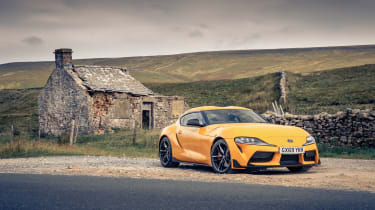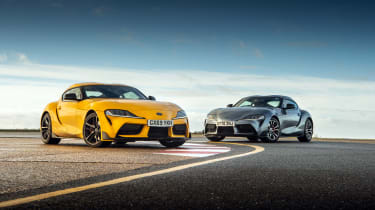Toyota GR Supra review - design
Traditional sports car proportions paired with unique design elements
Whatever Toyota did or did’t change under the skin, the Supra’s skin itself is every bit a Toyota design, and an original one at that. There’s little here to visually connect the Supra to Toyota’s other models, beyond a slightly bulbous nose that is recognisable from other Toyota models of the time. The design felt entirely fresh throughout the A90 Supra's life.
Whether it’s successful or not depends on your view of all the scoops and slats – many are non-functional, at least on the road car – and the car’s exaggerated curves. View the car from a low angle and it’s quite appealing, with a taut shape and some interesting details, such as the ducktail spoiler at the back. From higher angles there can appear to be a little too much metal, though you’ll get a good view of the Zagato-like double-bubble effect to the roof.
It has proper front-engined, rear-drive proportions anyway, and while it might share its platform with the BMW Z4, it’s the first-generation Z4 Coupe that comes to mind in the long bonnet and short cabin. It looks squat and wide, too, which is rarely a bad thing for sports coupes.
Fundamentally, all Supras in the UK look the same, save for the wheel designs. Despite helping out with the ride, the 2.0’s smaller 18-inch units can look a little under-wheeled compared to the 19-inch design on the 3.0, which not only look more dramatic with their twisted spokes and chrome inserts, but also accentuate the aggressive offset dialled in by Toyota.
Following the updates in 2022, 3.0 models in both manual and automatic forms picked up a set of less glamorous, but lighter forged 19-inch units with a design not dissimilar to that of the Enkei units found on the GR Yaris.





